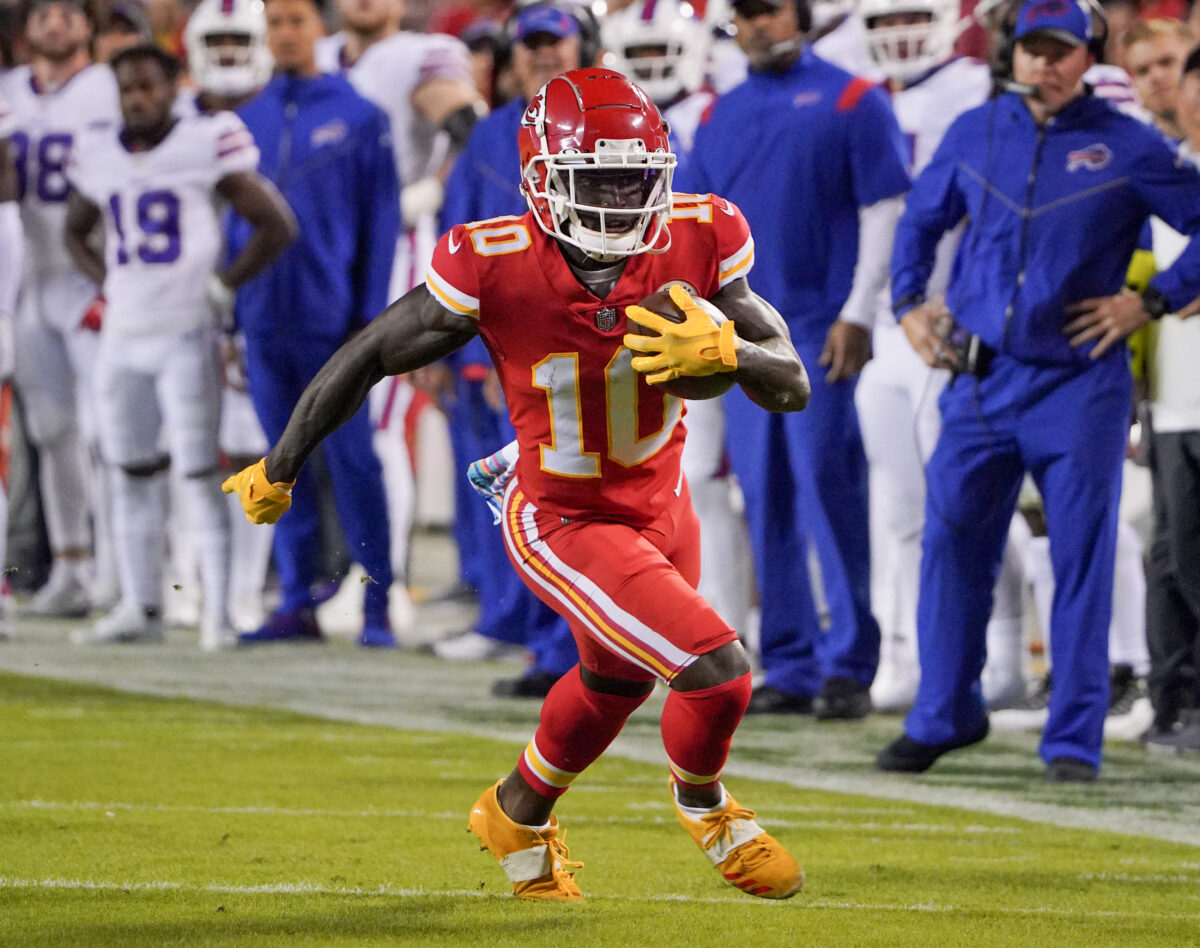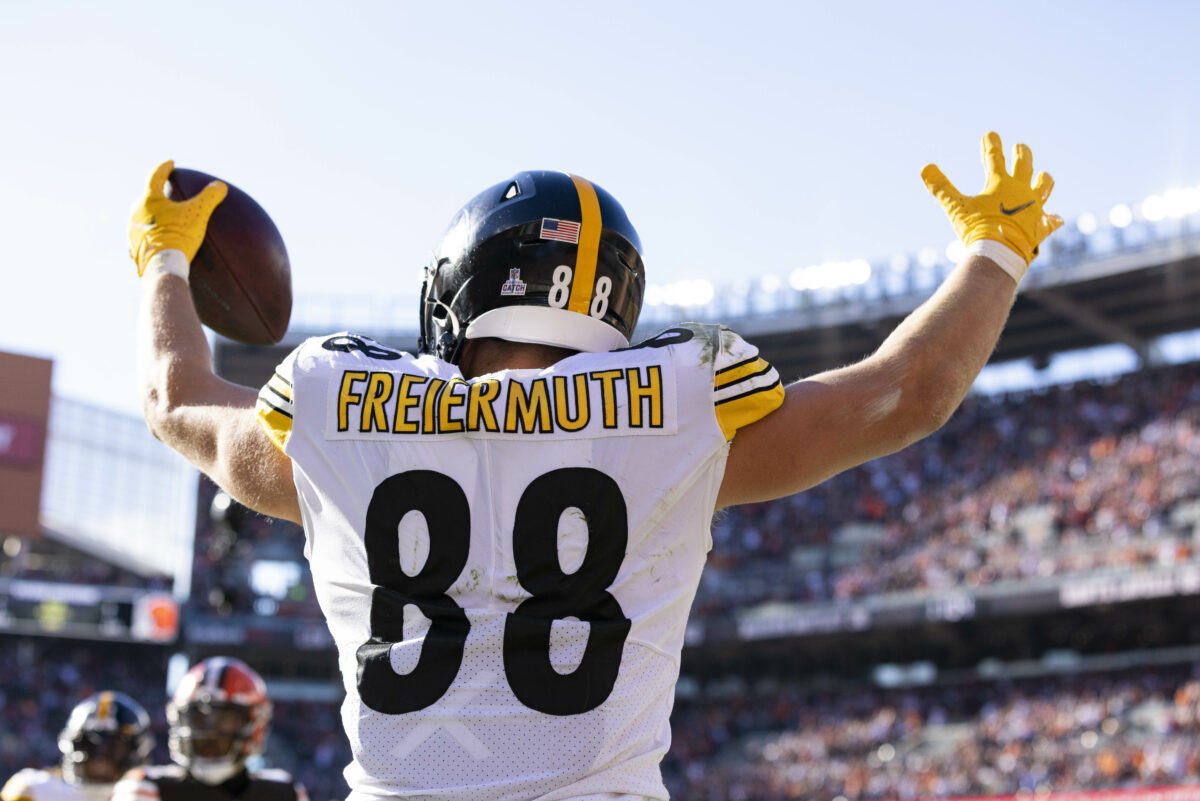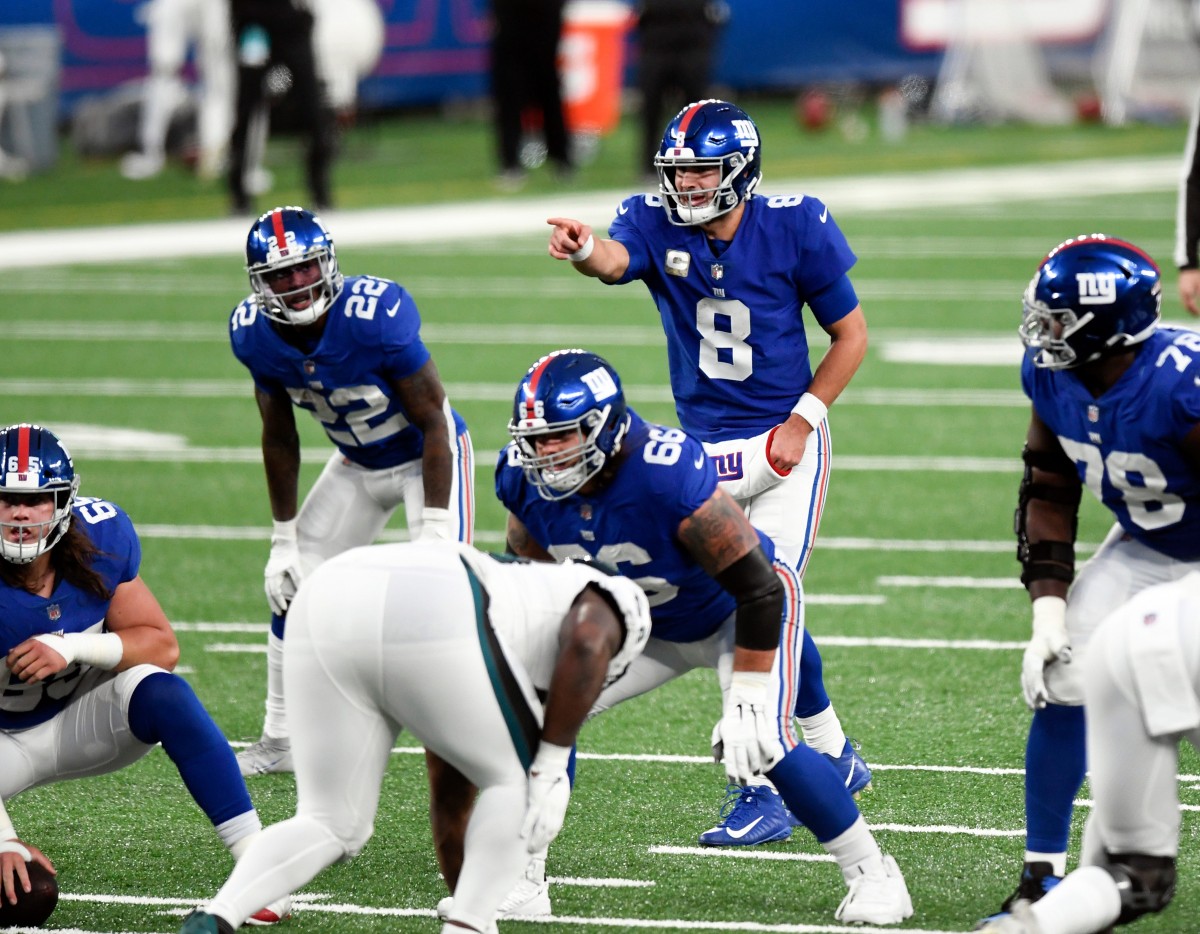NFL Week 4 is now in the books, which means we are roughly a quarter way through the 2021 fantasy season.
So with a decent sample size also in the ledger, here’s a six-pack of the more surprising fantasy-oriented statistics we’ve come across so far.
Here goes, starting with …
83.4 — total fantasy points (point-per-reception scoring) for Atlanta Falcons RB/WR Cordarrelle Patterson
Not only does that total easily lead all Falcons skill-position players — a contingent that includes top-five-round fantasy draft picks Calvin Ridley, Kyle Pitts and Mike Davis — but it trails only the Tennessee Titans’ Derrick Henry (101.5) and the Los Angeles Chargers’ Austin Ekeler (84.4) among all running backs and ranks behind just the Los Angeles Rams’ Cooper Kupp (102.6), the Kansas City Chiefs’ Tyreek Hill (102.3), the San Francisco 49ers’ Deebo Samuel (95.9), and the Carolina Panthers’ D.J. Moore (89.7) among wide receivers as he’s eligible at both positions on several fantasy league host sites.
More improbably, Patterson’s 83.4 fantasy points have come on just 49 total opportunities, 45 touches and 97 offensive snaps (a 34.4 percent share of Atlanta’s total offensive snaps).
And with his 354 total yards from scrimmage and five total TDs, it already ranks as the sixth-best fantasy season in nine years for the 30-year-old journeyman who’s playing on his fifth team.
Sure, scoring a TD on every ninth touch, as Patterson has this season, isn’t exactly sustainable, but this impressive start very likely will just lead to more snaps, opportunities and touches going forward for the 6-foot-2, 220-pound Patterson — especially with the lead back Davis struggling with low-efficiency averages of 3.1 yards per rush and 3.6 yards per touch.
It’s also been a slow start for Ridley so far with the wideout averaging career lows in yards per reception (9.4) and yards per target (6.1) while scoring one TD. The promising Pitts, meanwhile, is still awaiting his first trip to the end zone while going through the typical rookie tight end struggles with a 57.7 catch percentage on 26 targets.
5 — Rushing TDs for Carolina Panthers QB Sam Darnold, which not only paces all quarterbacks but is tied for the overall league lead.
Perhaps you’ve caught some of the clever “Cam” Darnold mentions, referencing a certain run-heavy former Carolina Panthers quarterback.
Now, sure, Darnold has as many ground scores as he does passing TDs so far, but his overall rushing figures aren’t exactly Newtonian numbers with Darnold only ranking 20th among quarterbacks with 52 rushing yards to date and averaging just 2.6 yards per carry. The five rushing TDs also have matched his career total entering the season after three campaigns with the New York Jets.
Let’s not short Darnold’s aerial start, though, as he’s passed for the sixth most yards (1,189) in the league so far while averaging a career-high 8.1 yards per attempt. His current passer rating (95.4) and QBR (62.7) are easily on track to hit career high-water marks.
Still, no QB has compiled more rushing fantasy points so far than Darnold’s 35.2 as he ranks fifth overall at the position with 114.7 total fantasy points. And while he doesn’t figure to continue scoring on 25 percent of his rushing attempts going forward, his 3.4 TD pass percentage is due some positive regression with the weapons at his disposal in Carolina as it ranks below his 3.7 percentage during his Jets’ tenure.
At the least, Darnold has put himself in the low-end QB1 conversation and looks to be quite the find as a last-ditch late pick in two-quarterback leagues.
0 — Running backs, tight ends or wide receivers currently ranked among the top 12 at their respective fantasy positions for the league’s highest-scoring (and only undefeated) team, the 4-0 Arizona Cardinals.
Notice we didn’t mention quarterback as Kyler Murray trails only the Kansas City Chiefs’ Patrick Mahomes (132.1) with 128.6 fantasy points (Huddle PPR scoring). Murray has had a hand in 12 of the Cards’ 16 offensive TDs with nine passing and three rushing scores to rank second among QBs with 12 total touchdowns.
But that’s where the fantasy predictability ends with the Cards.
Newly signed running back James Conner has accounted for the other four non-Murray offensive TDs — all on rushes of four yards or fewer — but those TDs account for more than half of his fantasy-point production as he ranks 25th at the position with 46.8 PPR points on 56 touches.
Holdover Chase Edmonds, meanwhile, ranks 13th among league running backs with a team-leading 395 total yards, including 140 on a team-high 20 receptions, but he has yet to find his way across the goal line on 63 touches.
At tight end, seventh-year vet Maxx Williams has been a nice surprise, reeling in 15 of his 16 targets for 179 yards and a TD to rank 13th at the position with 38.9 fantasy points.
The most surprising and intriguing numbers, though, belong to the Cards’ wide receivers.
It’s no shocker that DeAndre Hopkins is pacing the contingent in targets and fantasy points, but 6.25 targets and 14.4 fantasy points per outing isn’t what anyone envisioned when they spent a second-round fantasy pick on the veteran wideout, who currently ranks 24th at the position with 57.5 total points.
WRs Christian Kirk (52.4 fantasy points) and A.J. Green (51.8) also are top-30 fantasy receivers, ranking 29th and 30th, respectively, while rookie Rondale Moore (44.3) ranks 46th, thanks largely to a 24.4-point Week 2 outburst.
It’s been a tightly packed wideout quartet, though, with all four falling between 18-25 targets, 15-17 receptions, and 223-248 scrimmage yards.
Good news for Green, Kirk and Moore fantasy owners, but not so swell for the D-Hop GMs.
25 — targets for Los Angeles Rams WR Robert Woods, which is 21 fewer than teammate Cooper Kupp’s league-leading total of 46
Woods has led the Rams in targets in each of his first three seasons in L.A., averaging a robust 8.4 per game.
Kupp, meanwhile, has been essentially a co-WR1 with Woods, attracting only 10 fewer targets than his teammate the last two seasons following his injury-marred, eight-game 2018 campaign. In that time, Kupp averaged 8.0 targets per contest.
But with ballyhooed arrival of new QB Matthew Stafford this season, Kupp’s usage has soared to 11.5 targets per game, fueling his ascension to the top of the fantasy wideout heap with 102.6 total points.
Woods, meanwhile, has seen his per-game looks dip to 6.25 targets per contest, and he came out of Week 4 tied for 40th among wideouts with 46.0 total fantasy points. It’s been a frustrating start for Woods and his fantasy owners alike, and after he caught a 14-yard scoring pass in garbage time of Sunday’s 37-20 home loss to the Cardinals, he purposely flung the ball aside for emphasis.
Woods’ decline in targets also has led to an apparent conversation with head coach Sean McVay, who was quoted in a post-Week 4 interview saying “Robert is a leader, he’s a captain, and he’s been doing a great job up to this point. We just need to get him some more opportunities, and that starts with me.”
Don’t expect Kupp’s WR 1a status to change as he and Stafford simply have established too strong of a connection. But Woods is too talented to be taking this distant of a backseat, so look for his looks to jump up much closer to his 8.4-target average of recent seasons as opposing defenses invariably start shading more coverage Kupp’s way.
20 — receptions for Dallas Cowboys TE Dalton Schultz, which ranks fourth among league tight ends
Schultz also ranks fourth overall at the position of fantasy scarcity with 58.1 PPR points — an average of 14.5 per outing.
This isn’t a total shocker given that Schultz did finish 2020 ranked 10th among fantasy tight ends with 148.5 total points — an average of 9.3 per game. But with injured fellow tight end Blake Jarwin and QB Dak Prescott back from injuries that scuttled the majority of their 2020 seasons, and WR CeeDee Lamb’s anticipated second-year leap, Schultz’s fantasy production figured to go down — not up.
However, with opposing defenses far more concerned about the Cowboys’ other weapons, Schultz has taken advantage with a highly productive efficiency, reeling in 20 of 23 targets for 201 yards and a team-lead-matching three TD receptions.
Among league tight ends, only highly drafted studs Travis Kelce (24), Darren Waller (24) and T.J. Hockenson (22) have more receptions than Schultz so far.
Looking forward, WR Michael Gallup is due back soon from an early-season injury calf injury — just another reason why Schultz likely won’t wind up with enough target volume to maintain his elite TE1 ranking on a run-heavy team.
But, as 2020 and the first quarter of this season have shown, Schultz has earned a place as a starter in the majority of 10-team fantasy leagues.
86 and 55 — passing attempts and completions for New Orleans Saints QB Jameis Winston, the fewest in both categories among quarterbacks who have started four games
Only one team is attempting fewer than 25 passes per game or passing on fewer than 47 percent of their total plays. And it’s not the perennially run-heavy Baltimore Ravens or Cleveland Browns, who lead the league with an average of 177 ground yards per game.
Somewhat stunningly, it’s head coach Sean Payton’s New Orleans Saints, who are attempting only 22.5 passes per contest and throwing on 42.2 percent of their total plays — a full 5.0 percentage points behind the next lowest team, the Browns.
It’s most certainly a 180-degree turn from five seasons ago when the Drew Brees-led Saints ranked second in the league with an average of 42.1 passes per game — throwing on 63.4 percent of their total plays.
The lack of air attempts has certainly had an effect on fantasy fortunes in the Big Easy.
Jameis Winston has thrown for only 613 yards — a full 260 fewer than any other QB who’s started all four weeks. And even though Winston opened the season with five passing TDs and 31.1 fantasy points — on just 20 attempts and 14 completions — he’s totaled three aerial scores and 43.5 fantasy points in his three games since to rank 23rd among fantasy QBs on the season.
Only two New Orleans pass-catchers have double-digit receptions so far, with WR Deonte Harris leading the way with 11 for a team-high 164 yards.
Preseason WR sleeper Marquez Callaway has only drawn 13 targets in four games, catching nine of them for 137 yards and a TD. That’s 28.7 PPR points — 72nd among wideouts.
Stud RB Alvin Kamara is averaging a career-high 15.6 rushing attempts per game — way up from pre-2021 average of 11.2 — but his PPR value has taken a noticeable ding with only 10 receptions on his team-leading 14 targets for 62 yards so far to rank 15th among RBs with 57.9 total fantasy points.
Even with the expanded 17-game schedule, Kamara is on pace for 43 receptions and 264 receiving yards. He’s never had fewer than 81 catches and 533 receiving yards in any of his first four seasons.
Perhaps the pending midseason return of injured No. 1 wideout Michael Thomas will inspire more passing attempts in the Big Easy. But then again, Thomas could simply take his place on the list of fantasy victims of the new aerial-averse Saints.















